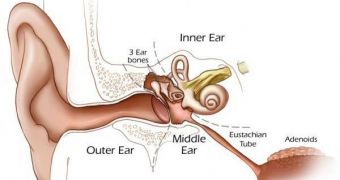A new research from the Stanford University School of Medicine comes to shed some doubts on the classic model of how the ear transforms sound into vibrations. Devised decades ago, the model has held bravely to criticism for many years, but it would seem that the recent study has finally managed to bring reasonable questions to some of its assumptions. The investigation recently conducted has proven that the ion channels that facilitate hearing are not located where biologists have thus far thought they are, a find that could have major implications for the way people are treated for progressive hearing loss.
“I had thought that the channels were in a very different place. This changes how we look at all sorts of previous data,” Oregon Health and Science University Professor of Otolaryngology Peter Gillespie, PhD, who has not been part of the new study, said. Details of the recent finds are published in a new scientific paper, which has been accepted for publication and will appear in the May issue of the scientific journal Nature Neuroscience.
“Location is important, because our entire theory of how sound activates these channels depends on it. Now we have to re-evaluate the model that we've been showing in textbooks for the last 30 years,” University of Wisconsin and the French-based Pellegrin Hospital Associate Professor of Otolaryngology Anthony Ricci, PhD, added. He explained that the new finds turned existing theories on themselves, and that a large number of medical procedures related to treatments applied to the ear would need to be totally changed, or at least partially.
Common wisdom has it that the interior of the ear is laden with what one calls “hair cells,” hair-like formations that are arranged by height. When air vibrations affect them, they slightly bend, in a process that experts believe to open a small ion channel at the bottom. As positively charged ions flow into the hair cell, the vibrations are converted into an electric impulse, which then travels to the brain via the auditory channel. Once in the portion of the cortex that integrates hearing, the electric impulse is again transformed, this time into the hearing sensation that we perceive.
In their recent investigation, the experts learned that the ion channels were, in fact, located at the base and at the middle of hair cells, and not in the highest rows, as they had first believed. This knowledge may help explain a few innate processes of the ear, including its adaptation to loud noises – defenses that the organs employ in order to prevent acoustic trauma to the ear drum, nerves, or brain, ScienceDaily reports.

 14 DAY TRIAL //
14 DAY TRIAL //